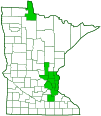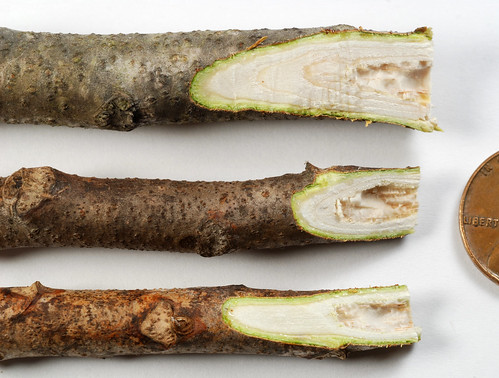poison sumac
(Toxicodendron vernix)
Conservation • Wetland • Description • Habitat • Ecology • Use • Distribution • Taxonomy
Description |
||
Poison sumac is a fast-growing, short-lived, deciduous, tall shrub or very small tree. It can be 10′ to 25′ tall and up to 6″ in diameter at breast height, though in Minnesota it is usually no more than 15′ in height and 2 ″ in diameter. The trunk is slender and is often branched near the base, and there are often vegetative sprouts at the base. The crown is small and rounded, with just a few wide-spreading branches. The bark is thin, light gray, and smooth or shallowly fissured. The twigs are moderately stout and orangish-brown or yellowish-brown. They are covered with conspicuous dark dots and splotches, and have numerous prominent, horizontal pores (lenticels). The leaf scars are large and shield-shaped, and has a number of scattered bundle scars. The terminal buds are broadly cone-shaped, ⅜″ to ¾″ long, and are covered with downy scales. When broken or cut, the twigs exude a dark sap. The leaves are deciduous, alternate, 6″ to 12″ long, and pinnately divided into 7 to 13 leaflets. They are on ¾″ to 3½″ long leaf stalks (petioles). The petiole and the central axis of the leaf (rachis) are red or yellowish-red. The rachis is hairless. The lateral leaflets are stalkless of on very short stalks. The terminal leaflet is on a ⅜″ to 1¼″ long stalk (petiolule). The leaflets are oblong to inversely egg-shaped or elliptic, 2″ to 4″ long, and 1″ to 1¾″ wide. They are wedge shaped at the base at an angle less than 90° and taper abruptly to a long point at the tip with concave sides along the tip. The upper surface is dark green, shiny, and hairless. The lower surface is pale green and hairless. The margins are untoothed. In autumn the leaves turn orange or red. Male and female flowers are usually borne on separate plants. They appear in early to late June after the leaves have developed. The inflorescence is a loose, branched cluster (panicle), up to 8″ long and 4″ wide, rising from the leaf axils of first-year twigs. The flower stalks may be hairless or covered with short hairs. The panicle is more or less erect in flower, conspicuously drooping in fruit. Individual flowers are about ⅛″ long. There are 5 sepals, 5 petals, 5 stamens on the male flower, and 1 style on the female flower. The sepals are green to cream-colored, united at the base, and divided into 5 teeth at the tip. The petals are greenish-yellow and 1 ⁄16″ to ⅛″ long. The stamens have white stems (filaments) and yellow anthers and protrude beyond the petals. The style has 3 lobes. The fruit is an almost spherical, ⅛″ to 3 ⁄16″ in diameter, fleshy, berry-like drupe. It is green and shiny at first, turning white or ivory-colored when ripe. It matures in late August to late September and persists on the plant throughout the winter. |
||
Height |
||
10″ to 15″ |
||
Flower Color |
||
Greenish-yellow |
||
Similar Species |
||
Habitat |
||
Wet. Mostly swamps but also marshes and wet meadows. Shade. Saturated, sandy or peaty soils. |
||
Ecology |
||
Flowering |
||
Early to late June |
||
Pests and Diseases |
||
Poison ivy sawfly (Arge humeralis): First instar larvae skeletonize the leaves, eating the leaf tissue and leaving only the midrib and the main veins. |
||
Use |
||
Toxicity |
||
The sap of poison sumac contains the allergenic urushiol. Urushiol is not a single chemical but a complex of five chemicals called alkylcatechols. Several exposures to the substance may be necessary to impart sensitivity. Research has shown that 85% of all people will develop contact dermatitis after adequate exposure. It usually takes 12 to 48 hours for a rash to develop on a previously sensitized person. In some individuals, a single exposure will cause a reaction. In these individuals, the rash will develop in seven to ten days. The lesions last 14 to 20 days. Rashes do not spread and are not contagious. Treatment can dry the blisters, reduce swelling, and relieve itching, but will not speed healing. Contact with the outer surface on an undamaged plant should not cause an allergic reaction unless there is residual urushiol present from a previous injury to the plant or a nearby plant. Contact with a torn leaf, broken or damaged stem or rhizome, or black spot will cause a reaction in those sensitized to urushiol. |
||
Distribution |
||||
|
Sources |
|||
| 11/20/2023 | ||||
Nativity |
||||
Native |
||||
Occurrence |
||||
Uncommon in Minnesota |
||||
Taxonomy |
|||
| Kingdom | Plantae (Plants) | ||
| Division | Tracheophyta (Vascular Plants) | ||
| Subdivision | Spermatophytina (Seed Plants) | ||
| Class | Magnoliopsida (Dicots) | ||
Order |
Sapindales (soapberries, cashews, mahoganies, and allies) | ||
Family |
Anacardiaceae (cashews) | ||
| Subfamily | Anacardioideae (cashews, sumacs, and allies) | ||
Genus |
Toxicodendron (poison ivies and oaks) | ||
Subordinate Taxa |
|||
|
|||
Synonyms |
|||
Rhus vernix Rhus vernicifera |
|||
Common Names |
|||
poison-ash poison-dogwood poison-elder poison sumac poison-sumac thunderwood |
|||
Glossary
Axil
The upper angle where a branch, stem, leaf stalk, or vein diverges.
Bundle scar
Tiny raised area within a leaf scar, formed from the broken end of a vascular bundle.
Drupe
A fleshy fruit with usually a single hard, stone-like core, like a cherry or peach; a stone fruit.
Filament
On plants: The thread-like stalk of a stamen which supports the anther. On Lepidoptera: One of a pair of long, thin, fleshy extensions extending from the thorax, and sometimes also from the abdomen, of a caterpillar.
Lenticel
A corky, round or stripe-like, usually raised, pore-like opening in bark that allows for gas exchange.
Panicle
A pyramidal inflorescence with a main stem and branches. Flowers on the lower, longer branches mature earlier than those on the shorter, upper ones.
Petiole
On plants: The stalk of a leaf blade or a compound leaf that attaches it to the stem. On ants and wasps: The constricted first one or two segments of the rear part of the body.
Petiolule
The stalk of a leaflet blade on a compound leaf.
Pinnate
On a compound leaf, having the leaflets arranged on opposite sides of a common stalk. On a bryophyte, having branches evenly arranged on opposite sides of a stem.
Rachis
The main axis of a compound leaf, appearing as an extension of the leaf stalk; the main axis of an inflorescence.
Visitor Photos |
|||||
Share your photo of this plant. |
|||||
| This button not working for you? Simply email us at info@MinnesotaSeasons.com. Attach one or more photos and, if you like, a caption. |
|||||
Jordan Wilson |
|||||
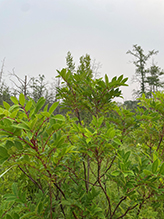 |
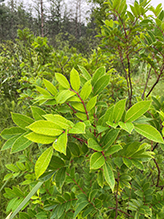 |
||||
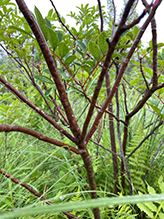 |
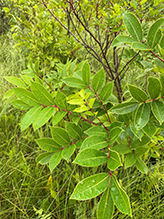 |
||||
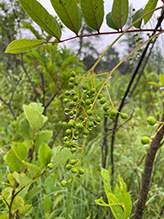 |
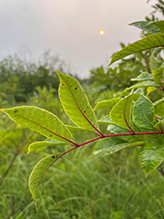 |
||||
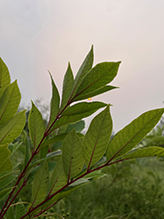 |
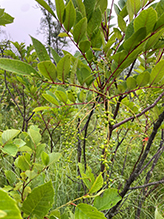 |
||||
Jaxon Lane |
|||||
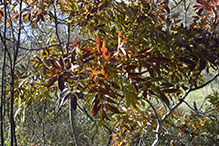 |
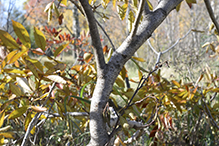 |
||||
MinnesotaSeasons.com Photos |
|||||
|
|||||

Visitor Videos |
|||
Share your video of this plant. |
|||
| This button not working for you? Simply email us at info@MinnesotaSeasons.com. Attach a video, a YouTube link, or a cloud storage link. |
|||
Other Videos |
|||
| Poison sumac Identification (Toxicodendron vernix) Peter Caine Dog Training |
|||
About
Published on Jul 2, 2017 Poison Sumac Toxicodendron vernix, commonly known as poison sumac, is a woody shrub or small tree growing to 9 m tall. It was previously known as Rhus vernix. This plant is also known as thunderwood |
|||
| Casting Call - Poison Sumac Plant (Toxicodendron vernix) cowman1970 |
|||
About
Published on Sep 8, 2014 When I made the shelter video I has accidentally came into contact with poison sumac. This video explains what the plant is, how to identify it, what happens if you come into contact with it, how you can avoid getting the rash/blisters, and what can be done to control the symptoms. |
|||
| Wild Moments: Poison sumac often misidentified wgaltv |
|||
About
Published on Jun 29, 2012 |
|||
| What does Poison Sumac Look Like? Tac |
|||
About
Published on Jun 9, 2015 |
|||
| Poison Sumac Identification Ditch The Itch |
|||
About
Published on Jun 12, 2017 Wetlands in Western Michigan. A very good video of Poison Sumac Identification. I am a licensed pesticide applicator in Michigan, and I specialize in noxious plants (Poison Ivy, Poison Sumac) |
|||

Visitor Sightings |
|||||
Report a sighting of this plant. |
|||||
| This button not working for you? Simply email us at info@MinnesotaSeasons.com. Be sure to include a location. |
|||||
| Jordan Wilson 7/15/2023 |
Location: Boot Lake SNA |
 |
|||
| Brien Larcom 7/7/2022 |
Location: Willmar, MN |
||||
| Jaxon Lane 10/19/2018 |
Location: Tamarack Nature Center |
 |
|||
MinnesotaSeasons.com Sightings |
|||||
|
|||||

Created: 10/23/2018
Last Updated:
